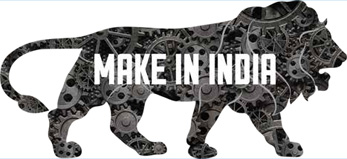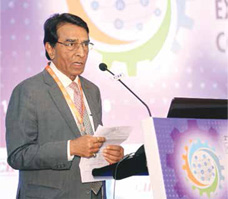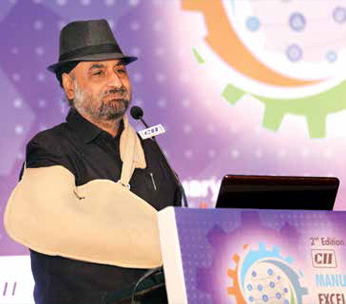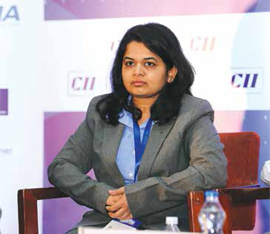To realise the dream of Make in India, we need doers who will create disruptive business models of engagement and help Indian manufacturers become globally competitive. We need to create a marketplace where manufacturing enterprises (from suppliers, OEMs and companies to supply chains) are fully integrated and adaptive to VUCA changes in the global and national manufacturing sector. At the recently-held CII Manufacturing Excellence Conclave 2018, at Hotel Westin, Pune, the second plenary session focused on the various success stories of Make in India initiative. The panellists for the session were, Anil Goel, Chairman, Duro Shox Pvt Ltd (Session Chair); Kaustubh Shukla, COO, Industrial Products Division, Godrej & Boyce Manufacturing Co Ltd; G.K. Pillai, MD and CEO, Walchandnagar Industries Ltd; Col. Rajinder Bhatia, President and CEO, Bharat Forge Defence and Aerospace; and Deepti Chandrachud, Director, Kwality Paints. Corporate Citizen, brings forth the learnings from top executives and successful organisations

Why operational excellence, why manufacturing excellence, why Make in India, when we can get it from elsewhere also? I have been in the industry for last fifty years and I started my entrepreneurial career in Pune, by manufacturing shock absorbers. When economy was opened we use to get threats from our customers, “Reduce the price or we will start importing from China”. That didn’t happen. Today, I am proud to say that I am exporting shock absorbers to China and I am exporting shock absorbers to the USA, which is the country that gave us this technology initially. And I have been recognised by Engineering Export Promotion Council (EEPC) of India, as the highest exporter for the last three years in succession, in this segment.

Why? I feel a lot of national pride—India was the centre of knowledge and learning in the golden days, but somehow we lost it. We are a race, which has always given to the world the best and I think we should do it now. It is not only because the Prime Minister says ‘Make in India’, it’s our moral responsibility towards our country. Don’t you want to ride a better car? Don’t you want your children to study in better schools? Don’t you want prosperity and see nice things around you? It is unfortunate that today our country is producing more children than wealth and that has to change. I don’t know how to stop producing more children, but I think we can definitely produce more wealth and that can only be done when we are the best.
Our culture is, we learn from storytelling. To-day we will hear from stalwarts of the industry; they will share their success stories and we have to take learning from them. Try and do the best for our country, for our self-respect, for our welfare and welfare of our people.
It is not only because the Prime Minister says ‘Make in India’, it’s our moral responsibility towards our country. Don’t you want prosperity and see nice things around you?
—Anil Goel
If you really want to make a defence industrial base, what will it need? In defence, we are nearly in the bottom half. Making defence and aerospace industry to grow, you need two parts-technology and manufacturing ecosystem. Technology, you need R&D, innovation and when you have both of these, disruptive technology will start coming out—we have lot of technology startups in the country. In manufacturing ecosystem it is competence, capability and if you have both of these, capacity will be a function of capital and business development.
I am sorry to say that the least number of startups today are in defence-they are more in ecommerce and many other streams, but not in defence. Why are there no startups in defence? Do we lack technology? Today, there are 870 MNC centres in this country and they employ close to 3,00,000 bright engineers of this country.

GE has the second largest setup in India-in the world after the US-and this centre is recruiting at the rate of 9 per cent per annum growth. So, we do have the capability, but the unfortunate part is that we as a nation have not been able to utilise it for ourselves.
Where do we stand in the global manufacturing ecosystem? We, as a manufacturing nation, are far superior to South Korea, US, Brazil and even Japan, especially in high-technology manufacturing. So, you have the ecosystem, you have the R&D and still you are not putting that to work for the country. Most of the executives think that India is the best place today to design, develop and manufacture innovative products.
If I talk about manufacturing competence, a company like ours, which had in 1990 a turnover of 200 crore, is today 7,700 crore. At that time we had 9 per cent of Indian market, today in a chosen product, we have 55 per cent of the global market. So, there is no shortage in this country of skill sets and manufacturing. Probably enablers are not in the right place, to make it happen.
What do we really need to do as initiative? We need to de-bottleneck innovation. We need to promote people at all levels and more so in assemblies, to come out with innovative ideas. Then we can surely switch from net importer to net exporter.
How do we create skill sets in our group? Our group turnover is close to about 2,000 crore today. Bharat Forge’s turnover is about 700–800 crore and defence in 12 years has reached to 12 per cent of Bharat Forge’s turnover, next year it’s going to be 15–18 per cent. How do we do it? We created a talent pipeline… we recruite people from tier-2 and tier-3 cities, with basic knowledge in maths and physics. We have our own test—after putting on 3–4 years of training on the shop floor, we select around 45–50 people every six months. So, we have a three-year course and 300 people undergo degree course with BITS Pilani and we run this course in our own university, with a campus in Pune. These are the people after the training, they come back to the shop floor. They start working on the shop floor as design engineer, quality engineer, production engineer, quality engineer. After working for 3–5 years, out of them 20–25 young boys are picked to do MTech with IIT-Powai and equal number to do MBA. Every year we pick up 2–3 people to do PhD—all this training is done on company expenses. Twelve to fifteen per cent of our manpower is on formal training at any given time. Then concurrently we started three highend technology sectors, in Pune, Hyderabad and Bangalore. And challenges taken were, whatever you were not able to do in this country, let’s do it with our own money. There is nothing that is difficult, it just the will power that has to be there and you can achieve what you want. We developed number of guns from 2012 to 2014—three guns. Each gun has about 3,000 to 5,000 new components and all components are designed, developed and manufactured by our own teams.
This country has some unique advantages; we are blessed with talent. Indian engineers have a unique capability to design and perceive items in three dimensions. It is no surprise that today two largest technology giants are headed by Indians. Second great advantage this country has, is the age—today average age is 32; by 2021, average age of Indians will be 29 years and 400 million will be getting ready for jobs. And the greatest point is our family ideology. An Indian parent will do everything, put their life savings, to educate their children. Nowhere in the world such family value exists and if such value exist this nation cannot fail. So, things can happen at a delayed interval, but it is certain that they will happen.
Indian engineers have a unique capability to design and perceive items in three dimensions. It is no surprise that today two largest technology giants are headed by Indians
—Col. Rajinder Bhatia

While Godrej is a 120-year-old conglomerate, but today I am going to focus on where we are working on with startup mentality. When we are talking about Godrej & Boyce, it is essentially known to be an appliance, consumer durable company and nearly 600 million people touch a Godrej product every day. But, we are much more than appliance and consumer durable company. We have done very significant contribution to space research, nuclear research, nuclear power generation, defence research and defence production. In 1897, a lawyer by profession, chose to defy the British dictate of not allowing Indian entrepreneurship. A Parsi lawyer could have done very well as a practising lawyer, but he chose to be an entrepreneur and that’s the spirit that runs in the company today. Things like developing the world’s first soap out of vegetable oils—that spirit of entrepreneurship has lived along.
Various products like manual typewriters, refridgerators, machine tools, process equipment, aerospace, defence equipment, nuclear equipment— we were among the first to produce them in the country. We also produce humungous process equipment—800 tonnes, 8 metres, some of them are 97 metres—are produced in Mumbai and sold and installed all over the world. We are talking about building reliability, accuracy, and tolerances of very high order. So, from consumer durables to very high-end equipment, that’s the kind of variety and spectrum, we are handling.
What are the organisational challenges? Very large portion is engineer-provided—every new project that we do execute, there is need of engineering requirements. Across projects, there is no similarity, so material of construction, the sequence of manufacturing, the type of vendors we deal with, the manufacturing processes, the assembly and assembly-based protocol-everything is different. So, how can one be nimble- footed, very agile in taking such projects and execute them well? It is very specialised, so we require very deep skills in a wide range of capabilities. This field requires high investment and facilities, infrastructure, high competence level of workforce—to be in the business you have to have it all, but then you have the issue of all of it not being utilised. There are many more challenges—maintaining machines at peak level, the man-machine-material everything has to be qualified for the particular project. If I have to summerise these challenges—shifting goal posts in manufacturing, and to do it productively, to do it reliably, what you want is a regimented way, repetitive way, so that you can really do it. The kind of work we are doing, require extremely intelligent people, not to look for better ways but to do it in the manner that we do and at the same time keeping them engaged, channelling their energies.
What has been our approach to really survive and do well? One is to accept reality—it’s a level- playing field, whoever is in this sector has to have it. Then you demystify—you have to do a good job doesn’t mean you have to compromise productivity. So, you must also learn to demystify. Skill is important and very crucial, but so is will. Highly skilled people tend to become indispensable and therefore their productivity drops—so willingness to learn new things and willingness to adapt is important.
Profits through people and processes ar something that has helped. Cost reduction would come later; people will get you the cost reduction, that’s the approach that we have. Customer-centricity improves the win-win. In our business of strategic industry, there are huge challenges. Good decisions come from experience and experience comes from bad decisions. We have been making in India since 1897, we have 3000 acres of land in Mumbai, out of which 1750 acres is conserved and preserved mangroves, and we call it Make in India, because this is probably the largest green lung that Maharashtra has.
Cost reduction would come later; people will get you the cost reduction, that’s the approach that we have. Customer-centricity improves the win-win
—Kaustubh Shukla

Today’s programme is on manufacturing excellence and we are looking at how we can excel in the field of manufacturing, along with ‘Make in India’ and success stories. When do we succeed, or when do we say that somebody has succeeded? In my 45 years of professional service, I was in public sector for about 26 years and 19 years I was in the private sector.
What makes an organisation succeed? India and Indians have been very much instrumental in innovation and today it is the buzzword everywhere. The Walchandnagar Industries has been in existence for last 109 years and we have been working with ethics, to do something for the country.
There are two segments of Indian industry- Make in India has been very successful. Apart from large and medium industries, there are many small industries in the country that have played a major role. The nuclear and space sectors are the two industries and if you look at these two sectors in Indian scenario—almost 100 per cent components of the launches which are made by ISRO, are manufactured in India by Indian industries, with Indian technologies. There are no collaborations for these items, which go into the spacecraft. Similarly, in the field of nuclear, as far as 700 megawatt plants are concerned… in the early seventies, after the Pokharan blast took place, the West stopped any support to the Indian industry or to the Indian nuclear programme. Industries like Godrej, L&T, Walchandnagar, all of them have worked with the Nuclear Power Corporation of India Limited (NPCL) and today as far as 700 megawatt power plant is concerned, not one item need be imported from anywhere in the world. There is a message in this—necessity is the mother of invention.
Today, if you want to set-up a steel or fertiliser plant, we still need a better technology from somewhere in Germany, Japan or Italy. But, if it is a nuclear plant or space programme, technology is 100 per cent indigenously available. Why we have been doing ‘Make in India’ in these two sectors, because we were forced to do that. An important point—if we are compelled to do something, we will definitely do that.
The third point which all of us can take pride in both these segments of space or nuclear, the private sector has played a major role in developing items. There has to be a real coordination between the private and the public sector. For a long time, defence has been kept reserved for the public sector. With regard to manufacture, Make in India, yes, there are companies who are doing it. In the area of Make in India and some of the success stories, the most important are technology transformation, people transformation and process transformation.
Which is the most important aspect in an organisation, which makes your organisation successful? It is the plant-level leadership and that has to be given more emphasis. Hundred years back, the founder, Walchand Hirachand, thought of putting a huge manufacturing setup. ‘Make in India’ has been in the country for long time, Indian companies have the capability; what we need is the mentality.
The most important aspect in an organisation, which makes it successful, is the plant-level leadership and that has to be given more emphasis
—G.K. Pillai

This is about development of water-based technology for industrial segment. We are a family- run organisation, founded by my father, Pradeep Chandrachud in 1980. We are 38-yearold company. We are manufacturers of automotive and industrial paints. Currently we are producing around 3 lakh litres of paint per month, which comes to around 10–12 thousand litres per day. We have over 80 employees and direct associates. I am really proud to say that we are contributing to the visionary mission of ‘Make in India’, by developing water-based technology, for industrial application, first time in India.
Our product portfolio is diverse, we supply paints for automotive applications, we are into general industrial segment, also into protective coatings of pre-engineered buildings and steel structures and plastic coatings. We have developed UV-curable coatings for plastic applications— the speciality of the product is that general paints take minimum half hour to cure or to dry, but this UV-curable coating is a radiation- curable technology and it hardly takes 3–4 seconds to cure.
About this green technology in paints (water- based technology)—the main important factor of paints are volatile organic compounds (VOC), these are chemical compounds, which evaporate at room temperature and they are hazardous to human health and environment as well. So, with this green technology, we can reduce VOC emission induction by 98 per cent. In general paints VOC is 400–450 grams per litre, in water based paints it is just 10–15 grams per litre. That is the major revolution in this technology.
We are contributing to the visionary mission of ‘Make in India’, by developing water-based technology, for industrial application, first time in India
—Deepti Chandrachud
We are a race, which has always given to the world the best and I think we should do it now —Anil Goel
‘Make in India’ has been in the country for long time, Indian companies have the capability; what we need is the mentality —G.K. Pillai
In our business there are huge challenges. Good decisions come from experience and experience comes from bad decisions —Kaustubh Shukla
With our green technology (water-based paints), we can reduce VOC emission induction by 98 per cent. That is the major revolution
in this technology
—Deepti Chandrachud
There is no shortage in this country of skill sets and manufacturing. Probably enablers are not in the right place, to make it happen —Col. Rajinder Bhatia
By Rajesh Rao